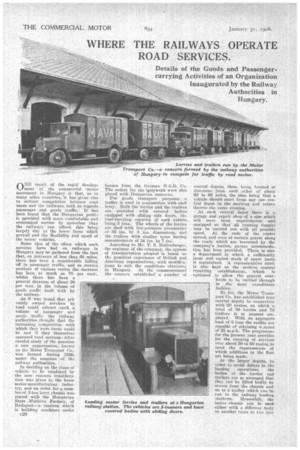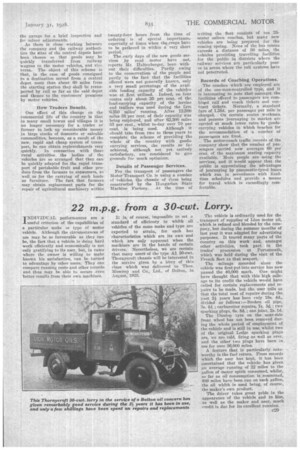WHERE THE RAILWAYS OPERATE ROAD SERVICES.
Page 50

Page 51

If you've noticed an error in this article please click here to report it so we can fix it.
Details of the Goods and Passengercarrying Activities of an Organization Inaugurated by the Railway Authorities in
ONE result of the rapid develop, meat of the commercial J motor movement in Hungary is that, as in many other countries, it has given -rise to serious competition between roan 'users and the railways, both as regards passenger and &sods traffic. It has been found that the Hungarian
is provided with more comfortable and economical service by motorbus than the railways can afford, this being largely due to the lower fares which prevail and the flexibility and speed of the motor vehicles.
Some idea of the effect which such services have had on railways in Hungary may be gathered from the fact that, en journeys of less than 60 miles, there has been a considerable falling off in passenger traffic, and on certain sections of various routes the decrease has been as Much as 70 per cent., whilst there has been a general -decrease of about 20 per cent. in the volume of goods traffic dealt with by the railway.
As it was found that privately owned services by road could attract such a volume of passenger and goods traffic the railway authorities thought that the increasing competition with which they were faced cottld be met if they themselves operated road services.' After eareful study of the question a new organization, known as the Motor Transport CO. was formed during192(1, under the auspices of the railway authorities.
In deciding on the class of vehicle to be employed by the new concern consideration was given to the home motor-manufacturing industry, and an. order for a number of 3-ton lorry chassis was placed with the Hungarian State Machine Factory, of Budapest-a concern which is building machines under c28 licence from the German N.A.G. Co. The orders for the hpdywork were also placed with Hungarian concerns.
For goods transport purposes a trailer is used in eunjunction with each lorry. Both the lorries and the trailers are provided with covered bodies equipped with sliding side doors, the load-carrying capacity of each vehicle being 3 tons. The wheels of the lorries are shod with low-pressure pneumatics Of 36 ins. by 8 ins, dimensions, and the trailers with similar tyres having measurements of 34 ins. by 7 ins.
According to Mr. T. S. Haltenherger; the engineer of the company, the system of transportation adopted, is based on the practical experience of British and American organizations, with modifications to snit the conditions obtaining in Hungary. At the commencement the concern established a number of
eentral depots, these being located at distances from each other o-! about 60 to 68 miles, the idea being that a vehicle should start from any one central depot in the morning and return thereto the same evening.
At each central depot there is a garage and repair shop of a size which will meet local, requirements and equipped so that all running repairs may be carried out with all possible speed. At the ends of the routes served; and even at certain points along the roads which are traversed by the company's lorries, garage accommodation has been provided. There is also a department in which a sufficiently large and varied stock of spare parts is maintained. A representative stock is atso kept at the modern central repairing establishment, which is equipped to allow the general overhauls to be carkied through in the Most expeditions fashion.
So far, the Motor Transport Co. has established four central depots in connection with 20 routes, on which a total of 50 lorries and 70 trailers is at present employed. With an aggregate load of 6 tons the outfits are capable of attaining a..speed of 25 m.p.h. The programme for the present year provides for the running of services over about 50 to 60 routes to meet the requirements of which additions to the fleet are being made.
At the larger depots, in erder to avoid delays in the loading operations, the bodies of the lorries and trailers are so arranged that they can be lifted bodily by cranes from the chassis and on to a trolley which can he run to the railway loading platform. Meanwhile, the motor chassis can be used either with a different body on another route or run into
the garage for a brief inspection and for minor adjustments.
As there is close working between the company and the railway authorities the sites of the central depots have been chosen so that goods may be quickly transferred from railway wagons to the motor vehicles, and vice versa. The object of this scheme is that, in the case of goods consigned to a destination served from a central depot more than about 60 miles from the starting station they shall be transported by rail so far as the said depot and thence to the customers' premises by motor vehicles.
Row Traders Benefit.
One effect of this change on the commercial life of the .country is that in many small towns and villages it is no longer necessary for a trader or farmer to lock up considerable money in large stocks of domestic or saleable commodities, because, as a result of the new, rapid and cheap system of transport, he can obtain replenishmants very quickly. In connection with these rural activities the bodies of the vehicles are so arranged that they can be quickly adapted for the rapid transport of perishable fruit and other produce from the farmers to consumers, as well as for the carrying of such loads as furniture. The fact that farmers may obtain replacement parts for the repair of agricultural machinery within
twenty-four hours from the time of ordering is of special importance, especially at times when the crops have to be gathered in within a very short period.
The early days of the new goods services by road motor have not, reports Mr. Halteuberger, been without their difficulties. Partly owing to the conservatism of the people and partly to the fact that the facilities offered were not generally known, only a very small percentage of the available loading capacity of the vehicle:, was at first utilized. Indeed, on four routes only about35 per. cent, of the. load-carrying capaCity of the lorries and trailers was used during the first 6,250 miles' running. After 12,500 miles 38 per cent, of their capacity was being eniployed, and after 62,500 miles 53 per 'cent., whilst to-day over 70 per cent. .is being used. Although it should take from two to three years to complete the scheme of providing the whole of the country with goodscarrying services, the results sofae achieved, although not yet entirely satisfactory, are considered to give grounds for much optimism.
Details of Passenger Services.
For the transport of passengers the Motor Transport Co. is using a number of vehicles, the chassis • of these being constructed by the Hungarian State Machine Factory. At the time of
writing the fleet consists of ten 23seater saloon coaches, hut many new vehicles are being prepared for the coming spring. None of the bus routes exceeds a distance of 80 miles, the vehicles providing travelling facilities for the public in districts where the railway services are particularly poor or in areas. where the rail systems have not penetrated.
Records of Coaching Operations. _ The coaches which are employed are of the one-man-controlledtype, and it is interesting to note that amongst the facilities offered to passengers are combined rail' and coach tickets and contract tickets. Normally, a standard fare of 1.38d. per passenger per mile is charged. On certain routes workmen and persons journeying to market are carried at much lower rates by goodscarrying vehicles in which benches for the accommodation of a number of passengers are fixed.
. The motor-coach traffic records of the company show that the number of pas. sengers carried now averages 60 per cent, of the maximum seating capacity available. More people are usiag the services, and it would appear that the public is appreciating the advantages of journeying by pneumatic-tyred buses which run in • accordance with fixedtime schedules and provide a means for travel which is exceedingly comfortable.












































































































